By Heather C Phanwar
Cartoons, which are precursors of comic books, were popular from the beginning of 1800s. The first comic strip was published in the mid-19th century in Europe. The history of Khasi comic books does not go beyond the seventies but there is not an iota less of excitement, drama, originality and more recently, colours, in the works of local artists.
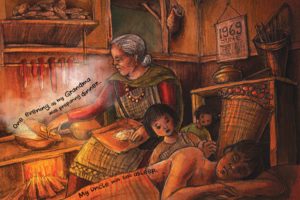
Khasi comics have evolved over time in terms of structure, content and the technology used.
Joshua Rynjah, a teacher whose article on the history of Khasi comics in Raiot webzine gives an insight into the artists’ world of imagination and evolution, says, in the 1970s and 80s, Khasi comics had two-panel pages and the illustrations were hand drawn in black and white.
“Comic books were published in 7×5½ inch page medium sized booklets (1/2 of A4). Today, writers and illustrators use the full page (A4) with four-panel pages, there is the use of digital rendering and colouring in illustrations and there is also the digital medium, which is very helpful in reaching out to a wider audience,” he explains the structural transformation.
The content of the vernacular comic strips varied from life and times of freedom fighters like Tirot Sing and Kiang Nangbah, Khasi folktales, social issues to stories of individuals. As time changed and a child’s world widened with the internet, the comic content also became diverse and contemporary.
Rynjah feels the old form of Khasi comics had “certain benefits” which made them easily available and popular. There was access to more affordable printing since comics were in black and white, had more publications and were available to more readers.
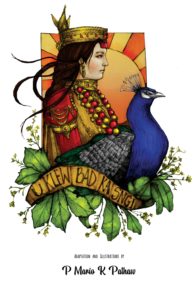
“Comic books in colour are not only time consuming to illustrate but also very expensive to print and thus their production and availability are limited,” he adds.
Nearly all comics are hand drawn but new-age artists go for hand-drawn digital images where they use a digital pen to draw the images on a tablet and digitally edit the colour, shading and text of the illustration.
Comic strips have a unique character as they “bridge the gap between the screen and the printed words and present both the image and the word together that makes them unique and appealing”, says Rynjah.
Pascal Mario Kmenlang Pathaw, the 27-year-old IIT-Bombay alumnus and graphic novelist, remembers how as a child, he would make illustrations of what he studied in textbooks and his teachers at St Edmund’s School encouraged him. He illustrated one scene from Shakespeare’s Julius Caesar into a comic strip when he was in Class X.
“There are graphic novels based on drama, tragedy as well as facts and information. Some (children) are not inclined to read novels but visuals can communicate a plot, a story or an information easily to the masses. It has always been throughout history, from the visual storytelling cave paintings and so on to the renaissance paintings and now in modern day, comics and graphic narratives,” says Pathaw, whose first graphic novel was The Living Root Bridge.
A graphic novel is longer with a complex story line. For Pathaw, his love for graphic novels was on a trial and error basis introduced by his friend Noel Jyothis.
Local colours
Vernacular comic strips are always interesting as they reflect quintessential local life and are easier for children both in urban and rural areas to understand them. Khasi comics like U Thylliej khlem shyieng and Ki Dieng Pyngkiang Ka Jingieit were quite popular.
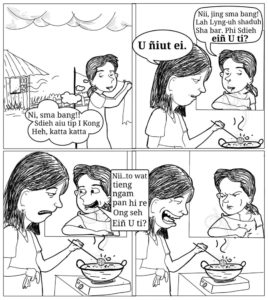
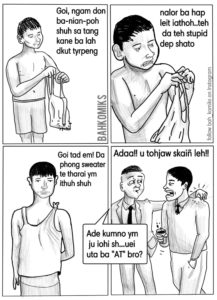
Kenneth Thangkhiew, a teacher and comic artist whose Instagram handle @bah_komiks features comics in Khasi and English and has over 800 followers, says, “Vernacular comics for children can be very informative and entertaining. It is a favourite form of literature for most children. It can create a lot of impact when it comes to social awareness and on the educational level. But there are not many vernacular comic strips for children in Shillong.”
But children today have a plethora of options in both national and international comic strips, some of which are a regular feature in local dailies, to choose from. The colourful graphics on glossy paper are always attractive to young readers and are a challenge for local artists.
Despite this tough competition, Khasi comics still have a local market, though most of it remains untapped. Pathaw says the market for graphic novels depends on how interesting the topics are. “The graphic novels in India are expensive and the question of accessibility comes into play. But if it is made affordable, at times the value also decreases,” he observes.
Rynjah feels that if more children here get access to Khasi comics, then they will nurture that interest even when they grow up. “Not only will Khasi comics help them in terms of language but they will be introduced to different aspects of Khasi history and culture. For example, if there was a Khasi comic book on a child’s day at Iewduh, it would not only entertain the children but also help them become aware of their own culture and community,” he explains.
Khasi comic strips can be marketable if the material is good and has aesthetic appeal, says Thangkhiew, adding, “By focusing more on our cultural background we can adapt its style and relevance to today’s modern psyche. The best example of this would be the popular Japanese Manga. Both the modern and traditional elements are adapted in a comic form.”
Citing an example of the content, Pathaw says if a graphic novel on Little Women is made, it would be a thick book with high price. But if comic strips on information about the current scenario, like the citizenship act, in the form of pamphlets are made, the content will reach a bigger spectrum as it will be affordable. “The pamphlet may not be valued after the information is taken. So accessibility depends upon the content and production,” he asserts.
Almost all artists whom Sunday Shillong spoke to firmly believe that social media is the way to go if an artist has to popularise his or her works.
Thangkhiew stresses the need for better collaboration among local artists for more published works. “Comic artists have to rise from their anonymity and become more active on social media, by drawing ideas every day, be it good or bad. Based on my observation, people using social media are open to Khasi comics, which get many shares and likes and even shared on WhatsApp,” says the artist who is active on Instagram.
Other artists, like Treiborlang Mawlong, are also aware of the benefits of the wide digital platform and the presence of youths there.
But Rynjah shows the flip side.
“Digital comic books will rarely be published in physical book form, thus remaining confined as an artist’s hobby. If there is a dedicated space for writers and artists to share their works and get paid for it, then there will be a more meaningful production of and readership for Khasi comic books,” he says.
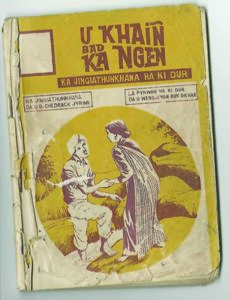
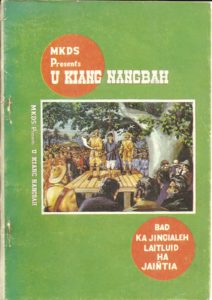
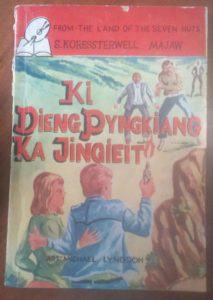
To plug this hole, the print media, like newspapers and magazines, can be of great help. While social media can give exposure, print can help young artists survive.
“Newspapers and magazines play a massive role in popularising this kind of art form. I have heard of people wanting to read comics first before scanning the major headlines and that gives me hope. At least, some sort of mental setting is in place and that people are aware of the existence of this art form,” says Thangkhiew, whose cartoons are regularly published in Highland Post.
“I think having Khasi comics as a subject for Khasi honours students (undergraduate and Master’s) will help in developing an appreciation of and awareness on Khasi comics. Also, the state government through its various departments such as Arts and Culture, Education, Tourism and so on can publish comic books in Khasi as a way to disseminate information and educate people on the culture and history of the community,” Rynjah suggests.
Treibor — who has published several comic strips including Lum Sohpetbneng Chronicles, A Train Journey, and A Father’s Devotion — agrees to the role of a publishing house “as it is with every comic culture in the world”.
“There should be a quarterly, if not monthly, publication to help comic artists easily publish their works,” he says
Challenges for artists
Challenges are aplenty for local comic artists who at times have to compromise on their creative pursuit for livelihood.
Comics, like any other art form, are time-consuming and demand full commitment. An artist needs money and a dedicated team. “I have met Khasi comic book writers and illustrators who published books in the 1980s and they speak of spending hours under candle light drawing, sketching and compiling their works. That is the same effort and dedication that is needed even in the present time. Comic books need a dedicated team of writers and illustrators who will be paid for their works. They need good marketing and affordable printing. In the present time, we have good printing presses,” says Rynjah.
Rynjah feels there is no dedicated team of comic book writers and Thangkhiew agrees. The latter cites the examples of Treibor and ‘Henpi Says’, another Instagram handle, who have popularised the Khasi comic style by reimagining Khasi folktales in the comic art form.
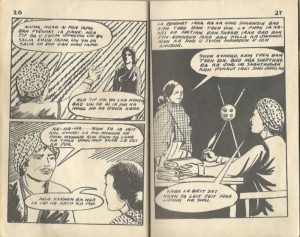
“Sadly, the art form is not so popular among today’s generation since it has been replaced by animation and other forms of entertainment. One can only hope for the art form to be received and loved by both the young and the old,” Thangkhiew points out while talking about how challenging time management is for him.
According to Treibor, the less number of local artists is probably because of lack of Khasi comic materials available in the market now or less demand for comics. At the same time, he contends that comics are not only for children but also adults.
“Children love pictures and when words are added to those pictures, it becomes even more interesting… But comics are not only for children and it can address sensitive adult issues too. Persepolis, Maus, Munnu-a boy from Kashmir are a few examples of serious stuff,” he adds.
Comics and graphic novels on varied subjects will never lose popularity and this is what has kept the local artists’ spirits up. They are confident that the vibrant colours of comic strips in Khasi language will bring smiles on faces amid vagaries of life.
“This profession can definitely grow in the state. Our state, our land, our culture holds a great gift, the gift of storytelling. The Khasi folktales are passed down verbally from one generation to the next. Khasi Hills not only holds fame for its natural beauty but also for the tales which creatively knit themselves into the natural beauty of the region,” says Pathaw.
(With inputs from Nabamita Mitra)



